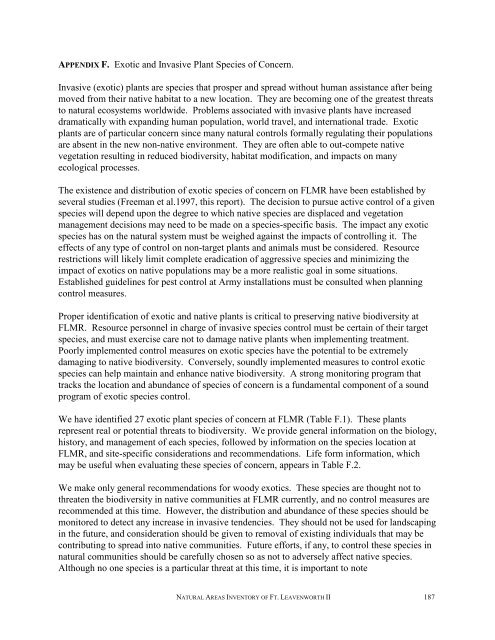A Natural Areas Inventory of the - Kansas Natural Heritage Inventory ...
A Natural Areas Inventory of the - Kansas Natural Heritage Inventory ...
A Natural Areas Inventory of the - Kansas Natural Heritage Inventory ...
You also want an ePaper? Increase the reach of your titles
YUMPU automatically turns print PDFs into web optimized ePapers that Google loves.
APPENDIX F. Exotic and Invasive Plant Species <strong>of</strong> Concern.<br />
Invasive (exotic) plants are species that prosper and spread without human assistance after being<br />
moved from <strong>the</strong>ir native habitat to a new location. They are becoming one <strong>of</strong> <strong>the</strong> greatest threats<br />
to natural ecosystems worldwide. Problems associated with invasive plants have increased<br />
dramatically with expanding human population, world travel, and international trade. Exotic<br />
plants are <strong>of</strong> particular concern since many natural controls formally regulating <strong>the</strong>ir populations<br />
are absent in <strong>the</strong> new non-native environment. They are <strong>of</strong>ten able to out-compete native<br />
vegetation resulting in reduced biodiversity, habitat modification, and impacts on many<br />
ecological processes.<br />
The existence and distribution <strong>of</strong> exotic species <strong>of</strong> concern on FLMR have been established by<br />
several studies (Freeman et al.1997, this report). The decision to pursue active control <strong>of</strong> a given<br />
species will depend upon <strong>the</strong> degree to which native species are displaced and vegetation<br />
management decisions may need to be made on a species-specific basis. The impact any exotic<br />
species has on <strong>the</strong> natural system must be weighed against <strong>the</strong> impacts <strong>of</strong> controlling it. The<br />
effects <strong>of</strong> any type <strong>of</strong> control on non-target plants and animals must be considered. Resource<br />
restrictions will likely limit complete eradication <strong>of</strong> aggressive species and minimizing <strong>the</strong><br />
impact <strong>of</strong> exotics on native populations may be a more realistic goal in some situations.<br />
Established guidelines for pest control at Army installations must be consulted when planning<br />
control measures.<br />
Proper identification <strong>of</strong> exotic and native plants is critical to preserving native biodiversity at<br />
FLMR. Resource personnel in charge <strong>of</strong> invasive species control must be certain <strong>of</strong> <strong>the</strong>ir target<br />
species, and must exercise care not to damage native plants when implementing treatment.<br />
Poorly implemented control measures on exotic species have <strong>the</strong> potential to be extremely<br />
damaging to native biodiversity. Conversely, soundly implemented measures to control exotic<br />
species can help maintain and enhance native biodiversity. A strong monitoring program that<br />
tracks <strong>the</strong> location and abundance <strong>of</strong> species <strong>of</strong> concern is a fundamental component <strong>of</strong> a sound<br />
program <strong>of</strong> exotic species control.<br />
We have identified 27 exotic plant species <strong>of</strong> concern at FLMR (Table F.1). These plants<br />
represent real or potential threats to biodiversity. We provide general information on <strong>the</strong> biology,<br />
history, and management <strong>of</strong> each species, followed by information on <strong>the</strong> species location at<br />
FLMR, and site-specific considerations and recommendations. Life form information, which<br />
may be useful when evaluating <strong>the</strong>se species <strong>of</strong> concern, appears in Table F.2.<br />
We make only general recommendations for woody exotics. These species are thought not to<br />
threaten <strong>the</strong> biodiversity in native communities at FLMR currently, and no control measures are<br />
recommended at this time. However, <strong>the</strong> distribution and abundance <strong>of</strong> <strong>the</strong>se species should be<br />
monitored to detect any increase in invasive tendencies. They should not be used for landscaping<br />
in <strong>the</strong> future, and consideration should be given to removal <strong>of</strong> existing individuals that may be<br />
contributing to spread into native communities. Future efforts, if any, to control <strong>the</strong>se species in<br />
natural communities should be carefully chosen so as not to adversely affect native species.<br />
Although no one species is a particular threat at this time, it is important to note<br />
NATURAL AREAS INVENTORY OF FT. LEAVENWORTH II 187


